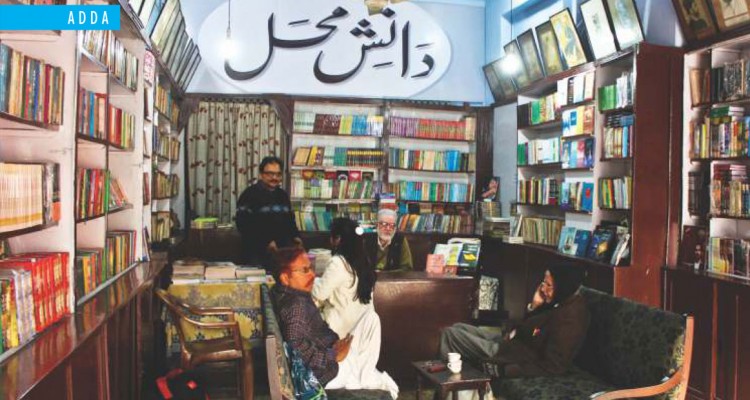Saira Mujtaba follows her nose to the musty interior of Danish Mahal, one of Lucknow’s most quaint temples of learning
Aminabad is not a favourite of diehard foodies alone, or those in love with jewellery and clothes. Apart from shops, there are many addas nestled in several legendary buildings in the area that have been a refuge of the literati for long. One such adda is the Danish Mahal, or palace of wisdom that still stands tall in clear defiance of time. It would be an understatement to call Danish Mahal a mere bookshop. Founded in 1939 the bookshop has also served as a home away from home for all book worms, in particular, those crazy about Urdu literature.
A balmy fragrance of books emanating from behind the glass doors leads book lovers to the quiet corridors of Zameer Mansion where Danish Mahal is situated in the heart of the commercial din and anarchic traffic of Aminabad.
This quaint ‘palace’ reeks of a different era as Mir Taqi Mir, Hasrat Mohani, Sir Syed Ahmed Khan, Mir Anees, Dabeer look down fondly at visitors from their portraits displayed on decades old walls of the bookshop. At first, it was just another franchise of Maktaba, a leading chain of agency of Urdu books, owned by Naseem Ahmad. Soon after, Maulvi Abdul Haque or Baba-i-Urdu or Father of Urdu inspired Naseem to convert the agency into a bookshop. Naseem called it Danish Mahal and the place came to be etched in golden letters in the history of adab, or culture of Lucknow. Naseem was a young man in his early twenties and passionate about the Urdu language that had flowered as the best reflection of the valued ganga-jamuni tehzeeb of the city. Naseem nurtured Danish Mahal also as a meeting place for writers, readers, scholars and patrons of Urdu literature.
Adda
Today, luminaries who were once regulars at the Danish Mahal, have either met their fate or have become too frail to venture out. In the past, there was no writer, critic, poet or scholar who did not visit Danish Mahal. From Abid Sohail, Ehtesham Hussain, Ratan Singh, Ram Lal, Maulana Shams Tabrez, to Aaley Ahmed Suroor, Basheshar Pradeep and Maulana Abdul Majid Dariyabadi, were only some to be lured by the rare collection of books that still adorn the wooden shelves of Danish Mahal.
Tilism-e-Hoshruba published by Newal Kishore Press was exclusively available here.
Ralph Russell, ex-Professor, London University wrote this in 1965: “Not only is Danish Mahal well-stocked and well-arranged, Naseem Ahmad’s resourcefulness in obtaining and supplying rare books is something to arouse both wonder and admiration…Danish Mahal is an institution, a cultural centre for all who love Urdu and its literature. Long may it continue to remain so!”
Always dressed impeccably in an ironed sherwani and donning a ‘kashti numa topi’, Naseem was not just a businessman dealing in books but a writer and litterateur himself. His articles on Professor Ehtesham Hussain were much acclaimed and printed in leading journals like Qaumi Awaaz and Naya Daur, leading newspapers of the time and treasured by the Urdu Academy. He was writing a book on Maulviganj, where he lived, but due to his illness he was unable to complete it.
The subdued breaths of the books, lined neatly upon the shelves, can be heard by the soul. Although rationality teaches to accept that the only constant in life is change, Naeem Ahmad, Naseem’s son, overflows with nostalgia for those were the days.
Together with his father’s childhood friend, Manzoor Parwana, Naeem eulogises the staid founder of the bookshop and his labour of love that Danish Mahal is. Naeem hopes to restart publishing from Danish Mahal.
He remembers his father saying, “Beta, even if you don’t feel like reading these books, just take a whiff of them and their pages. That too is enriching!”
Love for Urdu
Naseem’s passion prompted Naeem to end his own business the day his father fell ill in 2005. Ever since his father’s death in 2012, Naeem works tirelessly to make Danish Mahal once again a hub of Urdu literature. And it will be no exaggeration to add here that the Sham-e-Awadh meets held at Danish Mahal today are fanned by naseem, or fragrant breeze of Naseem’s memory that still lingers within the walls of the place, hoping to rekindle love for the Urdu language in many a hearts today.
In fact, all those who knew Naseem also remember him for his honesty and simplicity.
“He was an extremely knowledgeable, dignified, well-mannered and soft-spoken person,” says writer and satirist Azhar Masud. Similar voices speak of the man with equal respect.
“He was honest and had a simple and sensitive heart. Above all, his great love for Urdu literature was infectious,” adds noted writer Begum Masroor Jahan.
Weekly literary meets were organised at Danish Mahal, called ‘Bazm-e-Danishwaran’ where eminent writers, scholars, poets and critics exchanged views on literature, art, culture, society and politics.
With time, Urdu too has changed but it is a pleasant relief to see writers like Basheshar Pradeep still use Urdu alphabets on their name plate.
“Wedding cards, name plates and even epitaphs are written in the English language today because we consider Urdu to be backward”, says Naseem’s friend Manzoor who helps Naeem to keep alive the glory that Danish Mahal once was.
However, Manzoor regrets that there are no permanent teachers in the Urdu Department of Lucknow University and only ad-hoc ones today.
Why, is the question?

